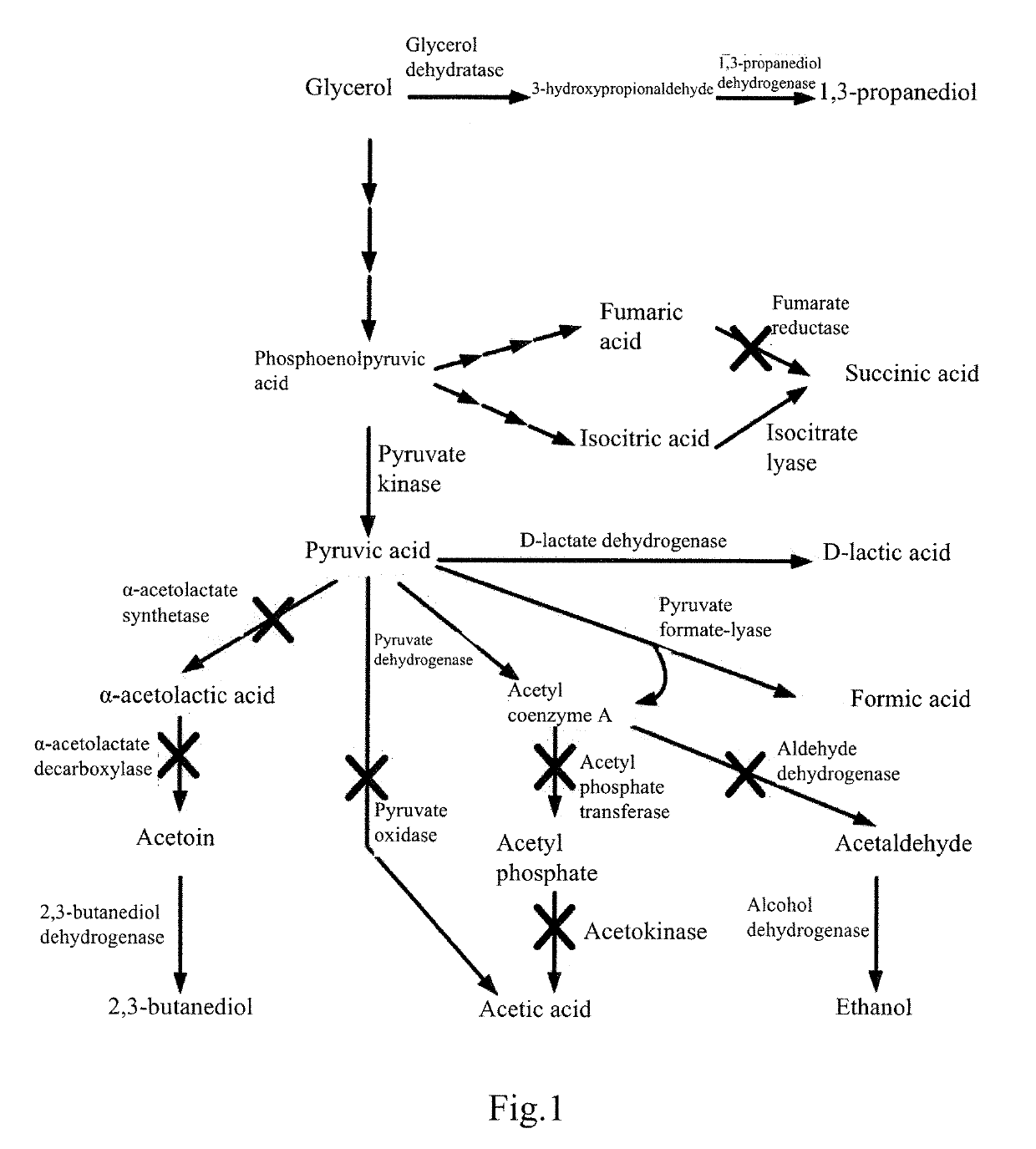Bacterium And Obtaining Method And Application Thereof
a technology of obtaining method and obtaining method, applied in the field of biological engineering, can solve the problems of not being able to realize simultaneous production of 1,3-pd and lac, and no strain capable of simultaneously producing 1,3-pd and optically pure lac, so as to reduce power and energy, facilitate the application of polymer materials, and improve pla performance.
- Summary
- Abstract
- Description
- Claims
- Application Information
AI Technical Summary
Benefits of technology
Problems solved by technology
Method used
Image
Examples
embodiment 1
d Identification of Strain Taking 1,3-PD and LAC as Main Products
[0113]2 g of soil sample was weighed and added into a 50 ml of glycerol liquid culture medium, the mixture was placed in a shaker for culture for 24 h at 37° C., and the shaker speed is 200 rpm. Then, aseptic normal saline was used for diluting the culture liquid respectively by 10 times, 100 times, 1000 times and 10000 times, then the culture liquid was coated into culture dishes containing a glycerol solid culture medium, and static culture was performed for 24 h at 37° C. After single colonies grew, single colonies with large colony area and acid-producing transparent circles were selected and inoculated into glycerol liquid culture mediums, the mixture was placed in a shaker for culture for 24 h at 37° C., and the shaker speed was 200 rpm. Centrifugation was performed to the culture solution, the yields of 1,3-PD and LAC in the culture solution were determined, and a strain which highly produces 1,3-PD and LAC and ...
embodiment 9
Fermentation Neutralizer
[0177]A neutralizer NaOH commonly used in production of 1,3-PD is used a neutralizer for regulating pH, and after 30 h of fed-batch fermentation performed to the PDL-5 strain, the yield of 1,3-PD is 41.1 g / L and the yield of D-LAC 71.5 g / L. Optical density (OD) of cells at 620 nm can reach 5.3. Cell OD herein always refers to optical density of cells at 620 nm. After other commonly used neutralizers such as KOH and NH3H2O are used, the yields of 1,3-PD and D-LAC do not obviously increase, and the yield of 1,3-PD is respectively 34.7 g / L and 34.8 g / L; the yield of D-LAC is respectively 61.6 g / L and 73.5 g / L; and cell OD is respectively 5.2 and 6.1.
[0178]When Ca(OH)2 is used as a neutralizer for coproduction of 1,3-PD and D-LAC, as shown by data of fed-batch fermentation of the PDL-5 strain for 30 h, the yields of 1,3-PD and D-LAC are respectively 76.2 g / L and 111.9 g / L, the cell OD reaches 12.5, and as compared with NaOH used as a neutralizer, the values are r...
embodiment 10
of Dissolved Oxygen Content in Fermentation Process
[0180]Since a key enzyme glycerol dehydratase for synthesizing 1,3-PD is an oxygen-sensitive enzyme, if the dissolved oxygen content is too high, the synthesis of 1,3-PD will be inhibited. Therefore, fed air has an influence on the production thereof. It is also reflected in other reports about synthesis of 1,3-PD through metabolization of glycerol. Usually, the optimum fermentation condition of synthesis of 1,3-PD through fermentation of glycerol is microaerobic fermentation. However, in biological process synthesis of LAC, usually anaerobic fermentation is adopted. However, in the production process of synthesis of D-LAC through fermentation of glycerol by using Klebsiella oxytoca reported recently, the writer finds that, under a microaerobic fermentation condition, with the increase of the amount of fed air, the synthesis of D-LAC will increase. Therefore, in experiments of coproduction of two substances, the inventor also needs ...
PUM
| Property | Measurement | Unit |
|---|---|---|
| temperature | aaaaa | aaaaa |
| concentration | aaaaa | aaaaa |
| concentration | aaaaa | aaaaa |
Abstract
Description
Claims
Application Information
 Login to View More
Login to View More - R&D
- Intellectual Property
- Life Sciences
- Materials
- Tech Scout
- Unparalleled Data Quality
- Higher Quality Content
- 60% Fewer Hallucinations
Browse by: Latest US Patents, China's latest patents, Technical Efficacy Thesaurus, Application Domain, Technology Topic, Popular Technical Reports.
© 2025 PatSnap. All rights reserved.Legal|Privacy policy|Modern Slavery Act Transparency Statement|Sitemap|About US| Contact US: help@patsnap.com


